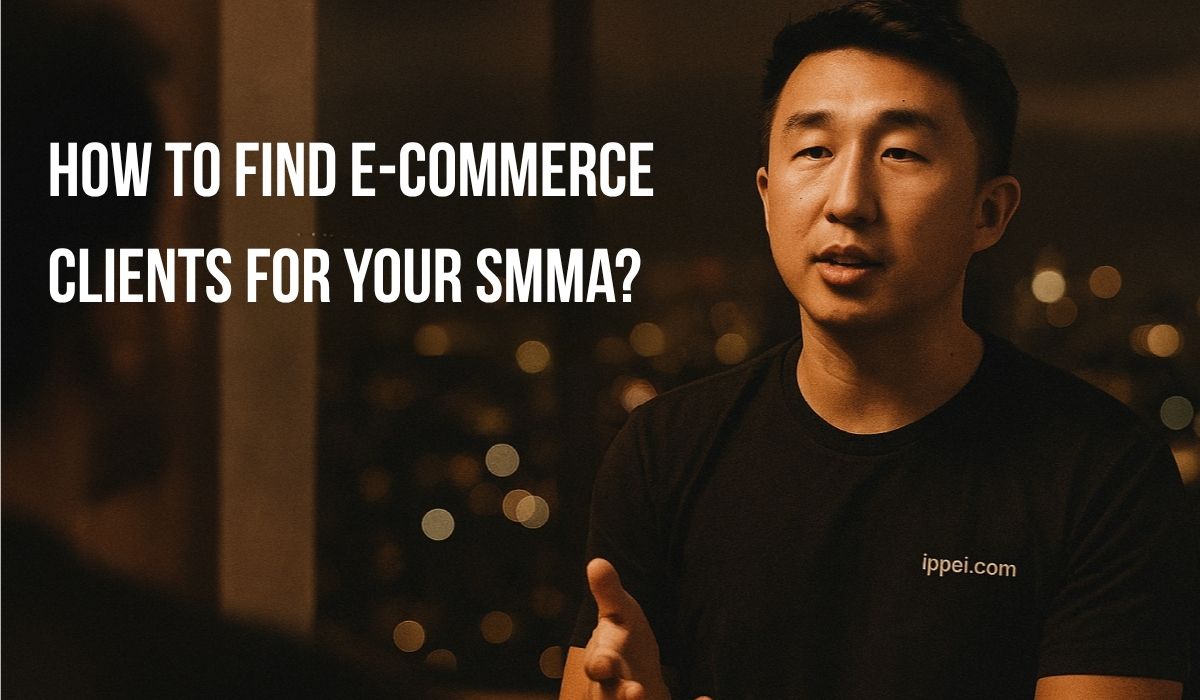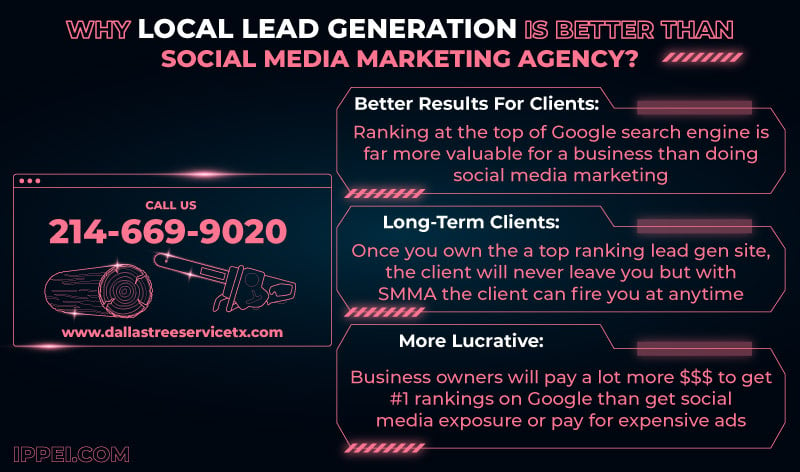How To Find E-Commerce Clients for Your SMMA?

To find e-commerce clients for your SMMA:
- Identify your ideal e-commerce client or niche down.
- Develop an irresistible offer (USP).
- Build a list of targeted e-commerce prospects.
- Reach out via cold email.
- Reach out via Instagram direct messages (DMs).
- Reach out via LinkedIn outreach.
- Follow up and optimize your outreach.
- Turn conversations into clients (closing the deal).
Finding e-commerce clients for your social media marketing agency (SMMA) starts with defining your niche. Specializing in industries like fashion, beauty, or fitness allows you to craft a targeted marketing strategy that directly addresses the needs of potential clients. Once your niche is clear, the next step is to develop a Unique Selling Proposition (USP). USP highlights how your services can increase sales, boost engagement, and drive conversions. A strong, results-driven offer will set you apart and make client acquisition easier.
With your niche and offer in place, prospecting and outreach become the focus. Start by building a list of qualified e-commerce businesses that fit your ideal client profile. Use cold emails, Instagram DMs, and LinkedIn outreach to introduce your services. Generic messages won’t work. Personalization is key. Tailor your outreach to address specific problems and provide simple solutions that show the value of your services.
According to Patrick Dang, LinkedIn is a powerful tool for finding e-commerce clients for your SMMA when used strategically. He highlights a three-step approach: clearly defining your offer, posting valuable content daily, and leveraging warm outreach. Instead of relying on cold messages, he recommends engaging with people who interact with your posts, visit your profile, or send connection requests, making outreach more personalized and effective. By sending 40 targeted connection requests per day and maintaining a strong content presence, SMMA owners can attract, engage, and convert e-commerce clients more efficiently than traditional cold email outreach.

To secure clients, consistent follow-ups and strong closing techniques are essential. Many e-commerce business owners won’t respond immediately, so a structured follow-up system will help maintain engagement. Once you establish contact, turning conversations into deals requires effective communication, proven case studies, and objection handling.
Iman Gadzhi believes that closing SMMA clients requires confidence, a clear sales process, and regular follow-ups. Many agency owners fail because they don’t follow up enough, causing them to lose potential clients. Gadzhi suggests using a two-call strategy. The first call is to understand the client’s problems, and the second call is to offer a solution based on their needs. This way, prospects stay engaged without feeling overwhelmed. Even after a good pitch, some clients may hesitate, so follow-ups are important. Gadzhi advises checking in, addressing concerns, and reminding them of the value of your service.

Finding SMMA clients is tough. It requires constant outreach, follow-ups, and long sales cycles while competing with other agencies. My experience with my marketing agency is that it takes too much of your time and often has low profit margins. I learned that success is mainly dependent on a good strategy. In this article, I guide you on how important it is to niche down and how to develop USP in finding your SMMA clients. Also, I show you how to leverage cold emails, Instagram, and LinkedIn in building your e-commerce prospect.
1. Identify Your Ideal E-Commerce SMMA Client (Niche Down)
Start by narrowing your focus to a specific niche and market. Instead of targeting broad niches, choose a specific sub-niche where you specialize. For example:
- Organic skincare brands
- Fitness apparel startups
- Handmade craft sellers
- Vegan and sustainable fashion retailers
- Specialty food and beverage companies
Select relevant e-commerce platforms. Research and identify the digital ecosystems your potential clients use. Many e-commerce businesses build their sites on platforms like Shopify, WooCommerce, or BigCommerce. For instance, boutique fashion and fitness apparel brands often prefer Shopify for its robust design options and scalability. Knowing the platform helps you tailor your strategies accordingly.
2. Develop a Unique Selling Proposition (USP) for SMMA E-Commerce Clients
- Craft a results-oriented USP. Shape your services to solve these issues. For example, you might state:
“We help organic skincare brands double their online sales in 90 days through targeted Facebook and Instagram ad campaigns.” - Highlight your SMMA services:
- Paid Advertising: Managing campaigns on Facebook Ads Manager, Google Ads, or even LinkedIn Campaign Manager for B2B outreach.
- Content Creation: Producing product videos, social media posts, and coordinating influencer collaborations using tools like Canva or Adobe Creative Suite.
- Conversion Rate Optimization (CRO): Enhancing website performance on platforms like Shopify or WooCommerce to boost sales.
3. Build a List of Targeted E-Commerce Prospects
Instead of emailing random businesses, you’ll save time and get better responses by building a highly targeted prospect list. Quality is more important than quantity here. Focus on e-commerce businesses that match your niche and appear to have the budget and need for your services. Take the time to gather correct contact info for each prospect (name, role, email, etc.), and maybe a note of why they seem like a good fit. This will help personalize your outreach in the next steps. An organized spreadsheet or a simple CRM (even a free one) can keep track of these prospects.
Leverage advanced search tools like:
- LinkedIn Sales Navigator: Filter prospects by industry, company size, location, and job title. For example, generate lists like “skincare brand founders in the US” or “CEOs of fitness apparel Shopify stores.”
- Apollo.io: Dive deeper by retrieving decision-makers’ contact details once you have a company name.
- Crunchbase: Identify e-commerce startups that have recently received funding or are rapidly growing—often a sign they’re ready to invest in marketing.
- Engagement check: Evaluate if they have an active social media presence or are running ads (using Facebook Ad Library, for instance) to determine if they’re already investing in marketing.
4. Reach Out via Cold Email
To find e-commerce clients for your SMMA via cold email, identify e-commerce businesses that could benefit from social media marketing. Look for brands that have:
- Active but underperforming Instagram and Facebook pages
- A Shopify or WooCommerce store with decent traffic but low engagement
- Limited or ineffective paid advertising campaigns
To structure your cold email for maximum response, include a:
- Subject line. Keep it clear, relevant, and enticing. A compelling subject is critical, as only 23.9% of sales emails are typically opened.
- Personalized introduction. Address the recipient by name and mention something specific about their business.
- Value proposition (your pitch). Clearly state who you are and how you can help. Keep it short but impactful. Use case studies or past results builds credibility and trust.
- Call to Action (CTA). Ask for a small commitment, like a quick call.
5. Reach Out via Instagram Direct Messages (DMs)
To find e-commerce clients for your SMMA through Instagram DMs, identify brands that could benefit from your services. This may be online stores that have active Instagram profiles but lack strong engagement, paid ads, or professional content strategies. Follow and interact with their content first. Liking, commenting, and replying to stories, will lead them to recognize your name when you message them. Once you’ve built some familiarity, send a personalized DM highlighting a specific way you can help them increase sales through Instagram marketing. Keep your message short, relevant, and conversational to increase response rates.
To successfully land clients via Instagram DMs:
- Engage before you DM. Follow the brand, like their posts, and leave meaningful comments on their recent content. This warms up the interaction, making your message more likely to be noticed.
- Start with a personalized opener. Avoid generic messages. Mention something specific about their brand. This makes your message feel authentic rather than a cold pitch.
- Introduce yourself & your agency. Keep it short and clear.
- Show immediate value. Highlight a past success story or benefit that’s relevant to them. This builds credibility and piques their interest.
- Keep the call-to-action (CTA) simple. Make it easy for them to respond. A low-pressure CTA increases response rates.
- Send DMs at the right time. Look at when they post or engage with their followers and send your message when they’re most active.
- Avoid spammy automation. Personalization is key. While tracking tools can help, sending genuine, tailored messages is the best way to get responses.
6. Reach Out via LinkedIn Outreach
To find e-commerce clients for your SMMA using LinkedIn outreach, find decision-makers like founders, CEOs, and e-commerce managers who oversee marketing and sales for their brands. Use LinkedIn’s advanced search filters or Sales Navigator to locate potential clients in your niche, whether it’s fashion, outdoor gear, or beauty brands. Once you’ve found the right prospects, send a personalized connection request that highlights mutual value. After connecting, engage with their content and follow up with a well-crafted message that clearly communicates how your agency can help them grow.
To successfully land clients via LinkedIn outreach:
- Find & filter decision-makers. Use LinkedIn Search & Sales Navigator to filter profiles by relevant titles such as:
- Founder
- CEO
- E-Commerce Director
- Head of Digital Marketing
- Review their profiles before reaching out. Check their recent posts, achievements, and company updates to personalize your outreach message.
- Send a personalized connection request. Keep your message brief, friendly, and relevant.
- Optimize your LinkedIn profile for credibility. Use a professional profile photo and an SMMA-focused headline. Ensure your summary highlights case studies and past successes to build trust.
- Follow up after connecting. Once your request is accepted, send a simple follow-up message reinforcing your value.
- Engage with their content before pitching. Like, comment, and engage with their posts to stay on their radar before sending a direct pitch.
- Use automation tools (when necessary, but carefully). Expandi or Dux-Soup can help automate outreach but should be used strategically to avoid LinkedIn restrictions. Use InMail for 3rd-Degree Connections when prospects are outside your network.
7. Follow Up and Optimize Your Outreach To Land E-Commerce Clients for Your SMMA
Following up is essential in converting e-commerce leads into clients for your SMMA. Many business owners are busy and may not respond to your first message. But consistent, strategic follow-ups can increase your chances of a reply. The Brevet Group says that 80% of sales require at least five follow-ups, and multiple follow-ups can boost response rates by up to 160%.
To do follow up effectively:
- Use multiple channels for outreach. If email gets no response, try LinkedIn or Instagram DMs instead. Always reference your previous message so they know why you’re reaching out.
- Provide value in every follow-up. Instead of just reminding them, share insights or quick recommendations relevant to their brand. Mention missed opportunities, marketing gaps, or trends they could benefit from.
- Track and improve your outreach. Use CRM tools like HubSpot or Pipedrive to log interactions and schedule follow-ups. Monitor open and response rates to tweak your subject lines and messaging.
- Stay Professional but Persistent. Keep your tone friendly and avoid sounding pushy. If there’s no response after four follow-ups, step back and revisit later with a new angle.
8. Turn Conversations Into Clients (Closing the Deal for Your SMMA)
Closing the deal is where you convert your outreach efforts into paying e-commerce clients for your SMMA. Once a prospect agrees to a call or meeting, your goal is to understand their needs. Present a compelling solution, and guide them toward signing a contract. This helps you build trust, handle objections, and ensure a smooth onboarding process.
To successfully close e-commerce clients:
- Prepare for your sales call or meeting. Start with a friendly introduction, thank them for their time, and mention something specific about their brand to establish a connection. Conduct a needs analysis. Ask targeted questions about their business goals and pain points. Listen carefully and take notes.
- Tailor your pitch to their needs. Clearly explain how your SMMA services address their challenges, such as increasing sales through paid ads, improving conversion rates, or boosting social media engagement. Use case studies or past client results to reinforce your credibility.
- Handle objections professionally. If concerns arise about budget, commitment, or ROI, address them with value-based responses (e.g., offering a small test campaign to prove results).
- Guide the conversation toward closing the deal. Summarize key takeaways and confidently propose a clear path forward. Use tools like PandaDoc or Proposify to provide a detailed proposal covering deliverables, pricing, and terms.
- Onboard your new client efficiently. Schedule a kickoff meeting. Confirm expectations, key performance indicators (KPIs), and communication channels. Provide a Welcome Packet (Optional). Send a brief guide outlining your process, your team, and next steps.
What are the Best SMMA Niches for Targeting E-Commerce Clients?
Automotive parts and accessories are the best SMMA niches for targeting e-commerce clients. These online stores sell car parts and accessories to both regular customers and repair shops. According to Forrester Research, U.S. B2B online sales are growing, but many auto parts retailers are still new to digital marketing. This makes it an open market with less competition, as many agencies avoid it due to its technical side. However, car dealers and repair shops are ready to invest in marketing if they see good results.
CBD and hemp products are another profitable niche. These stores sell CBD oils, supplements, and wellness items, but advertising rules make marketing difficult, so fewer agencies work in this space. The sexual wellness industry is also booming, with most sales happening online. Straits Research reports a rising demand for adult products, but advertising restrictions keep many agencies away. Businesses in this niche have high customer loyalty and strong profits.
Is Finding E-Commerce Clients for Your SMMA Hard?
Finding e-commerce clients for your SMMA can be hard because the market is crowded and you must show clear results. Many digital agencies compete for the same businesses. According to Promethean Research, there were over 45,000 digital marketing agencies in the US and Canada in 2023. While millions of online stores exist on platforms like Shopify and BigCommerce, only about 34% of small businesses outsource their digital marketing. This means your agency must work hard to stand out from the competition.
Winning e-commerce clients also requires strong proof of success. Many business owners worry about high costs and uncertain returns. BuzzBoard reports that 45% of small business owners find digital marketing too expensive, and 35% worry about the lack of measurable ROI. Brands selling fitness apparel or organic skincare look for agencies with proven success. HubSpot states that 79% of marketers consider case studies important when choosing an agency.
Why is It Easier To Find Clients on Local Lead Gen Than SMMA?
It is easier to find clients with local lead generation than SMMA because it delivers direct, trackable leads that businesses can immediately convert into customers. After ranking a website, customer inquiries and phone calls start coming in. They lead directly to sales. According to SearchEngineJournal, SEO-generated inbound leads have a 14.6% close rate, while outbound leads convert at only 1.7%. Business owners appreciate this direct impact on their revenue. It builds trust faster than less tangible metrics like likes or followers, which are often seen in social media marketing.
Local lead generation faces much less competition than SMMA. PrometheanResearch.com reports that over 45,000 digital marketing agencies operate in the US and Canada as of 2023. In contrast, local lead generation focuses on niche local markets. According to LocaliQ.com, only about 35% of businesses invest in local SEO, while roughly 96% use social media marketing. This lower competition allows local lead generation providers to stand out as one of the few specialists in their area, making it easier to secure clients and deliver consistent results.

Local lead generation also offers stable, recurring revenue. Providers typically charge a monthly fee or per-lead fee, ensuring steady income. LocaliQ.com states that nearly 40% of local SEO campaigns achieve a 500% or higher ROI. Marketing consultant Karl Sakas reports that well-run retainer services have under 20% annual client churn. Each local lead generation website can earn between $3,000 and $5,090 per month. If you are ready to build a profitable business with reliable monthly income, join our local lead gen program and start turning your websites into revenue machines today.

Follow Me
Ippei Kanehara
Founder/CEO
$52K per month providing lead generation services to small businesses
Ippei.com is for digital hustlers, industry leaders and online business owners.
His #1 online business recommendation in 2024, is to build your own lead generation business.